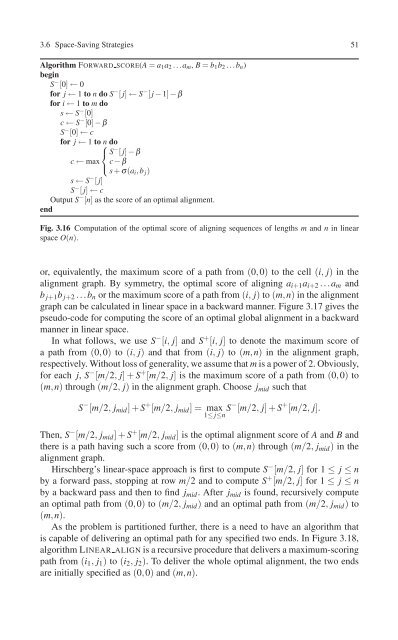Create successful ePaper yourself
Turn your PDF publications into a flip-book with our unique Google optimized e-Paper software.
3.6 Space-Saving Strategies 51<br />
Algorithm FORWARD SCORE(A = a 1 a 2 ...a m , B = b 1 b 2 ...b n )<br />
begin<br />
S − [0] ← 0<br />
for j ← 1 to n do S − [ j] ← S − [ j − 1] − β<br />
for i ← 1 to m do<br />
s ← S − [0]<br />
c ← S − [0] − β<br />
S − [0] ← c<br />
for j ← 1 to⎧n do<br />
⎨ S − [ j] − β<br />
c ← max c − β<br />
⎩<br />
s + σ(a i ,b j )<br />
s ← S − [ j]<br />
S − [ j] ← c<br />
Output S − [n] as the score of an optimal alignment.<br />
end<br />
Fig. 3.16 Computation of the optimal score of aligning sequences of lengths m and n in linear<br />
space O(n).<br />
or, equivalently, the maximum score of a path from (0,0) to the cell (i, j) in the<br />
alignment graph. By symmetry, the optimal score of aligning a i+1 a i+2 ...a m and<br />
b j+1 b j+2 ...b n or the maximum score of a path from (i, j) to (m,n) in the alignment<br />
graph can be calculated in linear space in a backward manner. Figure 3.17 gives the<br />
pseudo-code for computing the score of an optimal global alignment in a backward<br />
manner in linear space.<br />
In what follows, we use S − [i, j] and S + [i, j] to denote the maximum score of<br />
a path from (0,0) to (i, j) and that from (i, j) to (m,n) in the alignment graph,<br />
respectively. Without loss of generality, we assume that m is a power of 2. Obviously,<br />
for each j, S − [m/2, j]+S + [m/2, j] is the maximum score of a path from (0,0) to<br />
(m,n) through (m/2, j) in the alignment graph. Choose j mid such that<br />
S − [m/2, j mid ]+S + [m/2, j mid ]= max<br />
1≤ j≤n S− [m/2, j]+S + [m/2, j].<br />
Then, S − [m/2, j mid ]+S + [m/2, j mid ] is the optimal alignment score of A and B and<br />
there is a path having such a score from (0,0) to (m,n) through (m/2, j mid ) in the<br />
alignment graph.<br />
Hirschberg’s linear-space approach is first to compute S − [m/2, j] for 1 ≤ j ≤ n<br />
by a forward pass, stopping at row m/2 and to compute S + [m/2, j] for 1 ≤ j ≤ n<br />
by a backward pass and then to find j mid .After j mid is found, recursively compute<br />
an optimal path from (0,0) to (m/2, j mid ) and an optimal path from (m/2, j mid ) to<br />
(m,n).<br />
As the problem is partitioned further, there is a need to have an algorithm that<br />
is capable of delivering an optimal path for any specified two ends. In Figure 3.18,<br />
algorithm LINEAR ALIGN is a recursive procedure that delivers a maximum-scoring<br />
path from (i 1 , j 1 ) to (i 2 , j 2 ). To deliver the whole optimal alignment, the two ends<br />
are initially specified as (0,0) and (m,n).

















